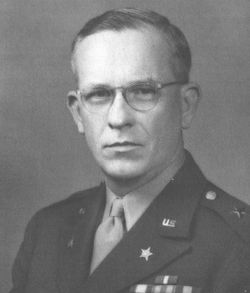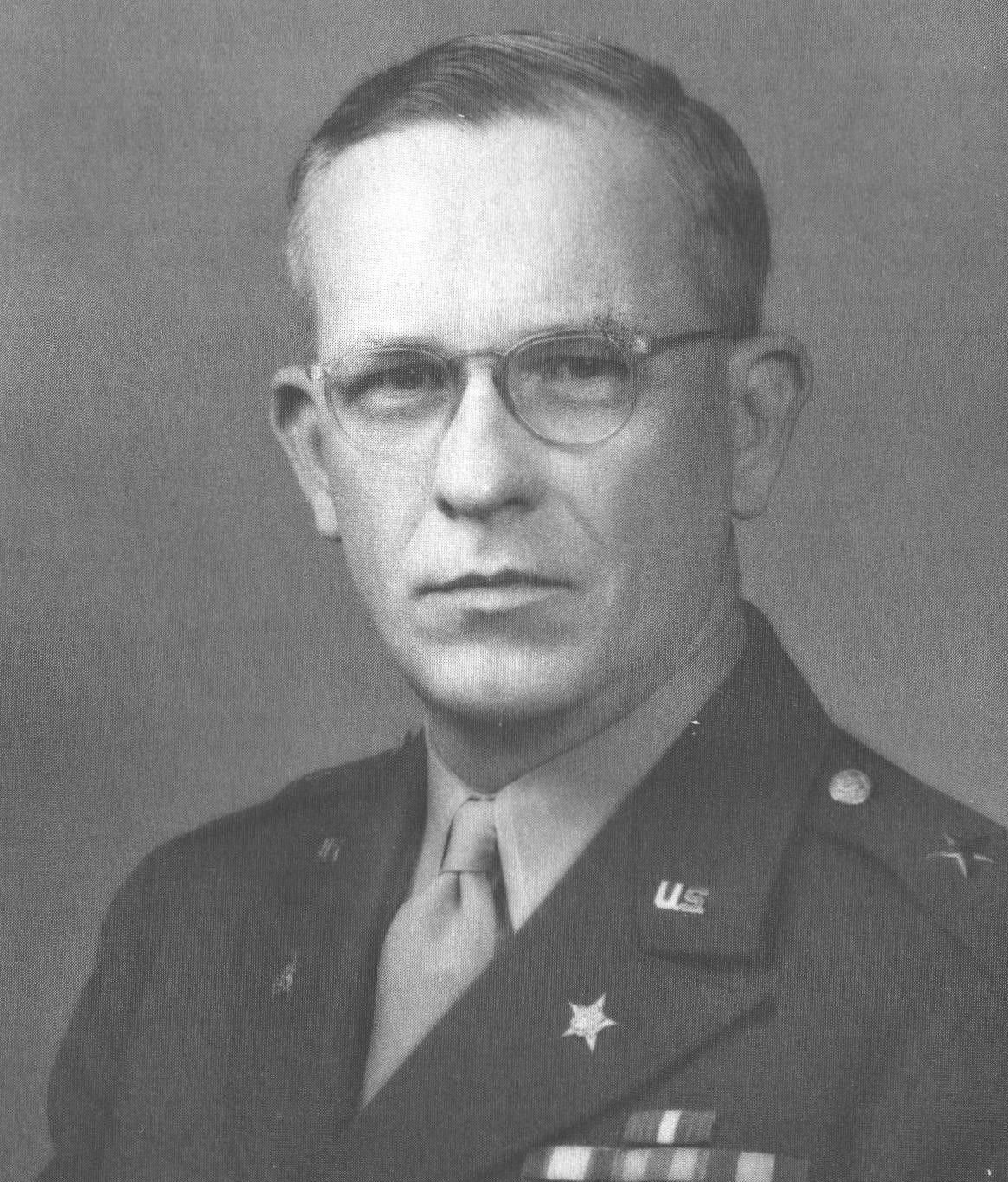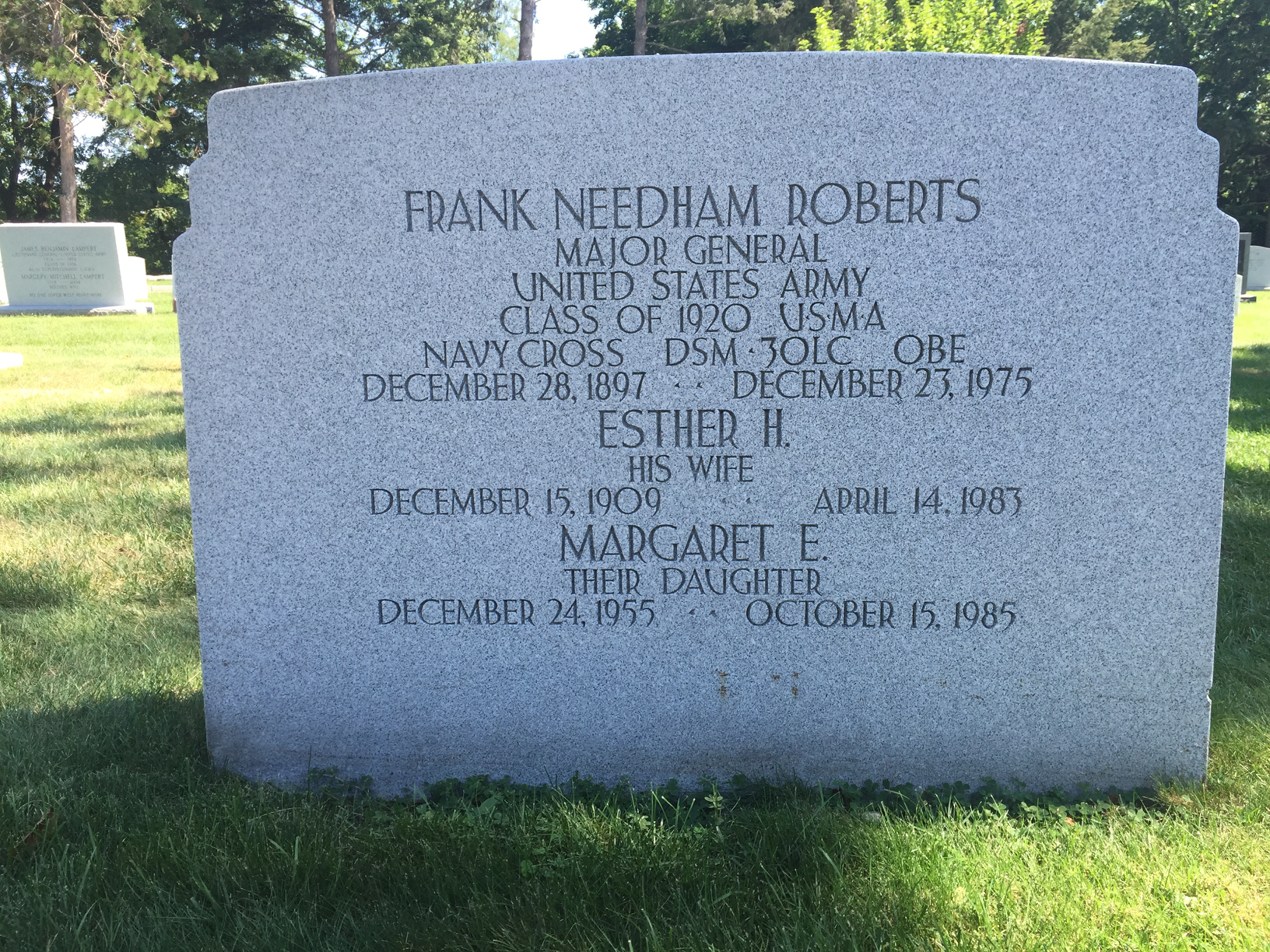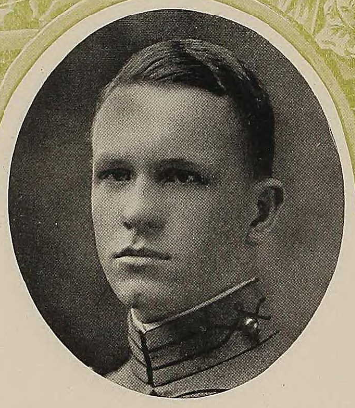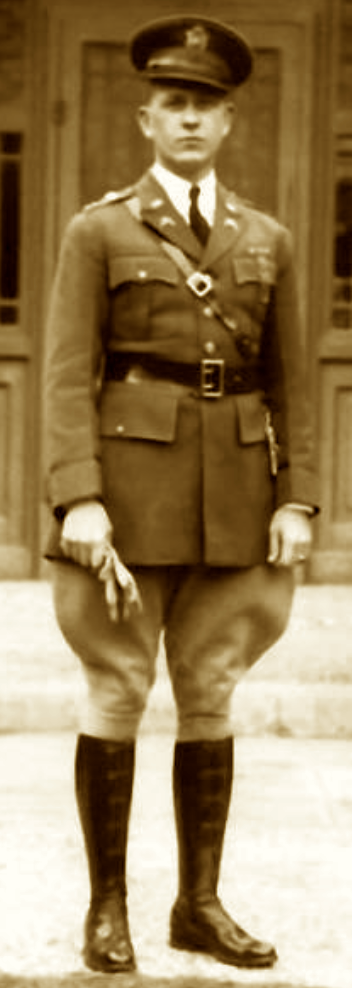He was the son of Francis Henry and Daisy Mae Needham Roberts.
On October 7, 1920 as Frank Roberts, he married Clara R. McCoy at the Episcopal Church at Columbus, Georgia.
He married Esther Elizabeth Borgmann at Los Angeles, California.
He was born in Oskaloosa, Kansas on December 28, 1897, the son of Francis Henry and Daisy Mae Needham Roberts. His father was the publisher of the Oskaloosa Independent, a newspaper founded by Frank's grandfather when Kansas was a territory. On May 10, 1916, he enlisted in the Kansas National Guard. His unit was mobilized with the 35th Division during World War I. He won his appointment to the United States Military Academy by competitive examination and reported to West Point on June 13, 1918. After graduation he completed the Officers' Basic Course at The Infantry School at Fort Benning, Georgia. He joined The Infantry School staff for two years as an instructor and later served four years as an instructor in the English Department at the United States Military Academy and one year as Commandant of the West Point Preparatory School at Presidio of San Francisco. In 1934, he was assigned to Peking, China, as Language Officer and Assistant Military Attaché at the United States Embassy. During the next four years he became fluent in Chinese and was known for his actions in the Panay Incident. In December 1937, he was on duty at the American Embassy in Nanking. All Embassy personnel had been moved on December 8, 1937 to the U.S.S. Panay, a gunboat of the Yangtze Patrol as Japanese forces were advancing on Nanking. On December 12, 1937, Japanese planes bombed the Panay, causing damage so severe that the ship's captain, Lieutenant Commander Hughes, United States Navy, ordered the ship to be abandoned. He was placed in charge as both Commander Hughes and his executive officer were incapacitated due to their wounds. He kept the fifty-four survivors, including thirteen seriously wounded, under cover of the high marsh-reeds to prevent detection by Japanese patrol boats and planes. At a nearby fishing village, he hired guides, improvised litters and litter-bearers and dispatched advance parties to Hohsien and Hanshan to check for Japanese troops and to notify the American Embassy at Hankow of the situation. At dusk the group hiked eight miles to Hohsien where shelter and food were available. On December 14, 1937, the Japanese Government made a formal apology for its mistake. He was awarded the Navy Cross and the Army Distinguished Service Medal for his actions. He was assigned to Fort Leavenworth and the Command and General Staff College, graduating in 1940. He served as G2 of the China-Burma-India theatre during the first Burma campaign and in August 1942, was assigned as Chief of the Strategy Section, Operations Division, War Department General Staff. He spent all of World War II in high-level planning. He served with the Operations Division, War Department General Staff, until November 1944, at which time he was Chief of the Policy and Strategy Group and was the Army member of the Joint and Combined Staff Planners. He attended the Cairo and the two Quebec Conferences. He spent June to October 1945 as War Department representative on the Far-Eastern Subcommittee, State-War-Navy Coordinating Committee which was the forerunner of the National Security Council. From August 1950 to July 1953 he served The Honorable W. Averell Hardman, then Special Assistant to the President and Director of Mutual Security, as his representative on the Planning Board of the National Security Council. In December 1944, he became the Chief of Staff, United States Military Mission to Russia and Chief of the Strategic Planning Group. His mission was to jointly plan for the war against Japan after V-E Day with the Russians, but the effort ended after six months. He and his group returned to the United States. He returned to Moscow a few months later as Military Attaché and participated in the Yalta Conference. In June 1946, he was reassigned as Military Attaché to the United States Embassy in Turkey. The Turkish army had applied to the Embassy for assistance under the Military Aid Program. Congress and the President approved the Turkish Aid Program in quantities greater than requested. In August 1948, he became Professor of Military Science and Tactics at the University of California, Los Angeles. While in Los Angeles he married to Esther Elizabeth Borgmann whom he had known for many years. Later, he was assigned to the Allied Forces, Southern Europe, North Atlantic Treaty Organization's Southern Command, with headquarters in Naples, Italy, where he served as Chief of Staff and received his promotion to Major General. His last active duty assignment was as Commanding General, Fort MacArthur, California and Chief of the California Military District. He retired in November 1957 after a career of thirty-seven years. He joined the Central Intelligence Agency in Washington, D.C., as a member of its Board of National Estimates and served for nearly three years until he became ill. He and his wife moved back to California, settling in Claremont. He was able to administer the oath of office to his son when he graduated with the USMA Class of 1974. He became ill before Thanksgiving in 1975 and died on December 23, 1975. He was survived by his wife, two sons and one daughter.
Source: United States Military Academy Association of Graduates memorial.
He was the son of Francis Henry and Daisy Mae Needham Roberts.
On October 7, 1920 as Frank Roberts, he married Clara R. McCoy at the Episcopal Church at Columbus, Georgia.
He married Esther Elizabeth Borgmann at Los Angeles, California.
He was born in Oskaloosa, Kansas on December 28, 1897, the son of Francis Henry and Daisy Mae Needham Roberts. His father was the publisher of the Oskaloosa Independent, a newspaper founded by Frank's grandfather when Kansas was a territory. On May 10, 1916, he enlisted in the Kansas National Guard. His unit was mobilized with the 35th Division during World War I. He won his appointment to the United States Military Academy by competitive examination and reported to West Point on June 13, 1918. After graduation he completed the Officers' Basic Course at The Infantry School at Fort Benning, Georgia. He joined The Infantry School staff for two years as an instructor and later served four years as an instructor in the English Department at the United States Military Academy and one year as Commandant of the West Point Preparatory School at Presidio of San Francisco. In 1934, he was assigned to Peking, China, as Language Officer and Assistant Military Attaché at the United States Embassy. During the next four years he became fluent in Chinese and was known for his actions in the Panay Incident. In December 1937, he was on duty at the American Embassy in Nanking. All Embassy personnel had been moved on December 8, 1937 to the U.S.S. Panay, a gunboat of the Yangtze Patrol as Japanese forces were advancing on Nanking. On December 12, 1937, Japanese planes bombed the Panay, causing damage so severe that the ship's captain, Lieutenant Commander Hughes, United States Navy, ordered the ship to be abandoned. He was placed in charge as both Commander Hughes and his executive officer were incapacitated due to their wounds. He kept the fifty-four survivors, including thirteen seriously wounded, under cover of the high marsh-reeds to prevent detection by Japanese patrol boats and planes. At a nearby fishing village, he hired guides, improvised litters and litter-bearers and dispatched advance parties to Hohsien and Hanshan to check for Japanese troops and to notify the American Embassy at Hankow of the situation. At dusk the group hiked eight miles to Hohsien where shelter and food were available. On December 14, 1937, the Japanese Government made a formal apology for its mistake. He was awarded the Navy Cross and the Army Distinguished Service Medal for his actions. He was assigned to Fort Leavenworth and the Command and General Staff College, graduating in 1940. He served as G2 of the China-Burma-India theatre during the first Burma campaign and in August 1942, was assigned as Chief of the Strategy Section, Operations Division, War Department General Staff. He spent all of World War II in high-level planning. He served with the Operations Division, War Department General Staff, until November 1944, at which time he was Chief of the Policy and Strategy Group and was the Army member of the Joint and Combined Staff Planners. He attended the Cairo and the two Quebec Conferences. He spent June to October 1945 as War Department representative on the Far-Eastern Subcommittee, State-War-Navy Coordinating Committee which was the forerunner of the National Security Council. From August 1950 to July 1953 he served The Honorable W. Averell Hardman, then Special Assistant to the President and Director of Mutual Security, as his representative on the Planning Board of the National Security Council. In December 1944, he became the Chief of Staff, United States Military Mission to Russia and Chief of the Strategic Planning Group. His mission was to jointly plan for the war against Japan after V-E Day with the Russians, but the effort ended after six months. He and his group returned to the United States. He returned to Moscow a few months later as Military Attaché and participated in the Yalta Conference. In June 1946, he was reassigned as Military Attaché to the United States Embassy in Turkey. The Turkish army had applied to the Embassy for assistance under the Military Aid Program. Congress and the President approved the Turkish Aid Program in quantities greater than requested. In August 1948, he became Professor of Military Science and Tactics at the University of California, Los Angeles. While in Los Angeles he married to Esther Elizabeth Borgmann whom he had known for many years. Later, he was assigned to the Allied Forces, Southern Europe, North Atlantic Treaty Organization's Southern Command, with headquarters in Naples, Italy, where he served as Chief of Staff and received his promotion to Major General. His last active duty assignment was as Commanding General, Fort MacArthur, California and Chief of the California Military District. He retired in November 1957 after a career of thirty-seven years. He joined the Central Intelligence Agency in Washington, D.C., as a member of its Board of National Estimates and served for nearly three years until he became ill. He and his wife moved back to California, settling in Claremont. He was able to administer the oath of office to his son when he graduated with the USMA Class of 1974. He became ill before Thanksgiving in 1975 and died on December 23, 1975. He was survived by his wife, two sons and one daughter.
Source: United States Military Academy Association of Graduates memorial.
Family Members
Sponsored by Ancestry
Advertisement
Advertisement
